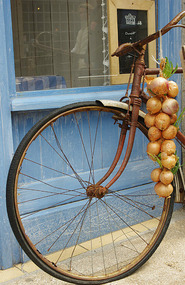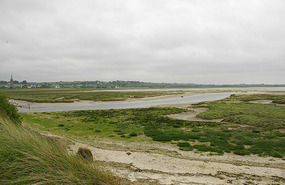On the 19th, we set off to do a scenic drive from our campsite in Landrellec, making our way to Roscoff. It was one of those gray, Vancouver days with heavy clouds, impending rain and no sun in sight. We stopped off at a pottery and artwork show in the garden of a pottery workshop. It was a great garden with lots of interesting artwork and we enjoyed wandering around for a bit. We then followed the coastline for the most part, making a quick stop in Locquirec to look for lunch (to no avail) and in Carantec for some views of an offshore fort and lighthouse, from the Pointe-de-Pen-al-Lann.
Just outside Morlaix, we noticed dozens of spectators lining the banks of a river. We pulled over and went to join them, curious to find out what was going on. It turns out it was the first annual home-made, themed, raft "race". The teams were all dressed up according to their theme (from "disco" and “Hawaiian” to “old time Mississippi”) and were trying to paddle down the river as fast as they could. There were flares, stereos blaring, and rafters splashing the other teams with water – this clearly wasn't a serious competition. We stood and watched them float by for a few minutes, wondering if some of the rafts would actually make it to the finish line. We camped that afternoon in St-Pol-de-Leon and since it was raining, decided to go into Roscoff the following morning.
The next day, we wandered into Roscoff just before lunch time so we had enough time to browse the menus. We found the “Crêperie de La Poste” partway through town and it had an excellent selection of crêpes. The interior was cosy, with large wooden beams supporting the ceiling and a fireplace in one corner. Megs and I both went for the scallops with leeks for our savoury crêpe and it was served steaming hot, with a slice of lemon. Both the crêpe and filing were delicious and we were soon on to our dessert ones. Megs opted for the “Poire Belle Hélène”, which is one with pears, whipped cream, hot chocolate sauce and a scoop of vanilla ice cream.
I chose the “Crêpe de la Poste” with banana, salted caramel sauce, a scoop of vanilla ice cream and flambéed with Cointreau. When they brought out my dessert, they brought out a little copper pot with the Cointreau in it. The waitress lit the Cointreau and as it was still flaming, poured it all over my crêpe. It all happened so quickly, I hadn't had time to get my camera out! The crêpes were so delicious that I was seriously contemplating returning for dinner or the next day for lunch. We then set off on our walking tour of the town, which turned out to have some nice views and interesting buildings, especially the church with its semi-cylindrical wooden ceiling. There were small information panels in front of each of the major stops throughout town, which I always find makes a walking tour more interesting. Roscoff is known for its seaweed and onions (which are AOC “Appelation Origine Controleé” protected) but both museums on these subjects were closed on account of it being a holiday. On the way out of town, we saw the house where Alexander Dumas (famous author of “The Three Musketeers”) stayed when writing the “onion” chapter of his “Great Dictionary of Cuisine”. We returned to camp mid-afternoon and decided to go for a swim in the indoor, heated swimming pool.
It was supposedly heated to 29 degrees, but it was still a bit cool and we were really hoping there was a hot tub. Regardless, it was still nice to use the campsite’s facilities and were glad for a hot shower afterwards. We got all dressed up in our nicer clothes to go out for dinner in Roscoff that evening as we had seen some potentially appealing menus when we had been looking for lunch. We went into town but a couple of the restaurants we had been interested in were closed. Determined not to go back empty handed, we picked up some kouign amann for dessert. Back at camp, Megs whipped up a tasty salad with eggs, bacon, apple and cheese and we had a kouign amann for dessert.
The following morning, we walked from camp into St-Pol-de-Léon to browse the market. It was a standard food market but you were left with no doubt you were in Brittany – cider, kouign amann and other Breton baked goods, artichokes and seafood. Brittany accounts for 70% of France’s artichoke production, which explains the numerous fields we’ve seen throughout the countryside. We picked up a sponge cake glazed with blackcurrants, cherries and other berries which would see us through tea for the next few days. We walked back to the campsite and headed off to the Keremma dunes.
The dunes are a partially natural phenomenon that began in the early 1900s when a local wanted to start farming the marshlands and began creating polders and draining off the water. The dunes are not significant in height but are a few kilometers long along the coast and now are home to many migratory birds. We walked a three kilometer loop through the dunes and spotted a few interesting birds (baby swans, sandpipers and a Tadorna, a brown chested duck with a red beak), and lots of rabbits that would all zip off into their holes at the first sound of you. It was an enjoyable walk but we were sure glad to get out of the wind and warm up on our drive to our next campsite just outside Camaret-sur-Mer.
Crepes in Roscoff and the Keremma dunes
Monday, May 20, 2013
 Roscoff, Brittany, France
Roscoff, Brittany, France
Other Entries
-
125Van repaired and a visit to Brighton
Apr 1139 days prior Brighton, United Kingdomphoto_camera16videocam 0comment 1
Brighton, United Kingdomphoto_camera16videocam 0comment 1 -
126Open Air Museum in Arnhem
Apr 1436 days prior Arnhem, Netherlandsphoto_camera55videocam 0comment 2
Arnhem, Netherlandsphoto_camera55videocam 0comment 2 -
127Amsterdam
Apr 1733 days prior Amsterdam, Netherlandsphoto_camera72videocam 0comment 2
Amsterdam, Netherlandsphoto_camera72videocam 0comment 2 -
128Aalsmeer Flower Auction
Apr 1832 days prior Aalsmeer, Netherlandsphoto_camera47videocam 3comment 0
Aalsmeer, Netherlandsphoto_camera47videocam 3comment 0 -
129Cheese Market in Alkmaar
Apr 1931 days prior Alkmaar, Netherlandsphoto_camera62videocam 0comment 0
Alkmaar, Netherlandsphoto_camera62videocam 0comment 0 -
130The Historic Triangle
Apr 2030 days prior Hoorn, Netherlandsphoto_camera81videocam 2comment 3
Hoorn, Netherlandsphoto_camera81videocam 2comment 3 -
131Fishing Village of Marken
Apr 2129 days prior Marken, Netherlandsphoto_camera21videocam 0comment 1
Marken, Netherlandsphoto_camera21videocam 0comment 1 -
132Edam, Tulips & Windmills
Apr 2228 days prior Lisse, Netherlandsphoto_camera49videocam 0comment 1
Lisse, Netherlandsphoto_camera49videocam 0comment 1 -
133Canal Boating on the Bourgogne
May 0119 days prior Migennes, Francephoto_camera110videocam 5comment 3
Migennes, Francephoto_camera110videocam 5comment 3 -
134Trapped by the Floods
May 0416 days prior Fleurey-sur-Ouche, Francephoto_camera48videocam 1comment 0
Fleurey-sur-Ouche, Francephoto_camera48videocam 1comment 0 -
135Canal Boating on the Lateral Canal to the Loire
May 0911 days prior Briare, Francephoto_camera99videocam 3comment 4
Briare, Francephoto_camera99videocam 3comment 4 -
136Dinan
May 137 days prior Dinan, Francephoto_camera42videocam 0comment 1
Dinan, Francephoto_camera42videocam 0comment 1 -
137Coastal Walk & Saint Malo
May 146 days prior Saint-Malo, Francephoto_camera21videocam 0comment 0
Saint-Malo, Francephoto_camera21videocam 0comment 0 -
138Fort-la-Latte & Cap Frehel
May 155 days prior Fort-la-Latte, Francephoto_camera40videocam 0comment 0
Fort-la-Latte, Francephoto_camera40videocam 0comment 0 -
139Paimpol & the Sillon de Talbert
May 164 days prior Paimpol, Francephoto_camera24videocam 0comment 0
Paimpol, Francephoto_camera24videocam 0comment 0 -
140Île-de-Bréhat
May 173 days prior Île-de-Bréhat, Francephoto_camera74videocam 1comment 0
Île-de-Bréhat, Francephoto_camera74videocam 1comment 0 -
141Bird Spotting and the Pink Granite Coast
May 182 days prior Perros-Guirec, Francephoto_camera56videocam 1comment 0
Perros-Guirec, Francephoto_camera56videocam 1comment 0 -
142Crepes in Roscoff and the Keremma dunes
May 20 Roscoff, Francephoto_camera46videocam 0comment 0
Roscoff, Francephoto_camera46videocam 0comment 0 -
143Beautiful views near Camaret
May 222 days later Camaret-sur-Mer, Francephoto_camera42videocam 0comment 0
Camaret-sur-Mer, Francephoto_camera42videocam 0comment 0 -
144Crepes in Locronan
May 233 days later Locronan, Francephoto_camera20videocam 0comment 0
Locronan, Francephoto_camera20videocam 0comment 0 -
145Quimper
May 244 days later Quimper, Francephoto_camera22videocam 0comment 0
Quimper, Francephoto_camera22videocam 0comment 0 -
146Artist Village of Pont Aven
May 255 days later Pont-Aven, Francephoto_camera8videocam 0comment 0
Pont-Aven, Francephoto_camera8videocam 0comment 0 -
147A relaxing day in Quiberon
May 266 days later Quiberon, Francephoto_camera15videocam 0comment 0
Quiberon, Francephoto_camera15videocam 0comment 0 -
148Megaliths and Thundershowers
May 288 days later Vannes, Francephoto_camera35videocam 0comment 0
Vannes, Francephoto_camera35videocam 0comment 0 -
149Marais Poitevin
Jun 0112 days later Saint-Hilaire-la-Palud, Francephoto_camera45videocam 1comment 0
Saint-Hilaire-la-Palud, Francephoto_camera45videocam 1comment 0 -
150Ile de Ré
Jun 0314 days later Saint-Martin-de-Ré, Francephoto_camera45videocam 0comment 0
Saint-Martin-de-Ré, Francephoto_camera45videocam 0comment 0 -
151Exploring around Royan
Jun 0617 days later Royan, Francephoto_camera97videocam 0comment 0
Royan, Francephoto_camera97videocam 0comment 0 -
152Sarlat Market, a third visit
Jun 0819 days later Sarlat-la-Canéda, Francephoto_camera50videocam 0comment 0
Sarlat-la-Canéda, Francephoto_camera50videocam 0comment 0 -
153Saint-Cirq-Lapopie and the Cuzals farm museum
Jun 0920 days later Saint-Cirq-Lapopie, Francephoto_camera93videocam 3comment 0
Saint-Cirq-Lapopie, Francephoto_camera93videocam 3comment 0 -
154Millau Viaduct and the Roquefort Caves
Jun 1021 days later Millau, Francephoto_camera37videocam 0comment 0
Millau, Francephoto_camera37videocam 0comment 0 -
155Scenic Drives, Views and Caves near Meyrueis
Jun 1425 days later Meyrueis, Francephoto_camera164videocam 3comment 0
Meyrueis, Francephoto_camera164videocam 3comment 0 -
156Commuting to the Camargue
Jun 1627 days later Saliers par Arles, Francephoto_camera85videocam 0comment 2
Saliers par Arles, Francephoto_camera85videocam 0comment 2 -
157Exploring the Chateau in Les Baux
Jun 1728 days later Les Baux de Provence, Francephoto_camera55videocam 0comment 1
Les Baux de Provence, Francephoto_camera55videocam 0comment 1 -
158Perched Village of Gordes
Jun 2031 days later Gordes, Francephoto_camera45videocam 0comment 0
Gordes, Francephoto_camera45videocam 0comment 0 -
159Great Market, Incredible Ice Cream & Amazing Views
Jun 2132 days later Lourmarin, Francephoto_camera42videocam 0comment 0
Lourmarin, Francephoto_camera42videocam 0comment 0 -
160Ochre Quarry in Roussillon
Jun 2233 days later Roussillon, Francephoto_camera77videocam 0comment 0
Roussillon, Francephoto_camera77videocam 0comment 0

 Roscoff, Brittany, France
Roscoff, Brittany, France
















































2025-05-22